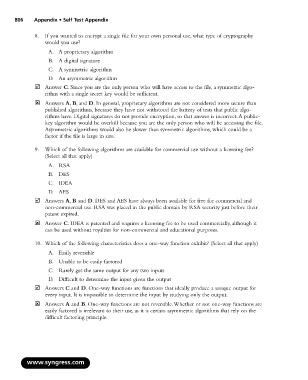Page 822 - StudyBook.pdf
P. 822
806 Appendix • Self Test Appendix
8. If you wanted to encrypt a single file for your own personal use, what type of cryptography
would you use?
A. A proprietary algorithm
B. A digital signature
C. A symmetric algorithm
D. An asymmetric algorithm
Answer C. Since you are the only person who will have access to the file, a symmetric algo-
rithm with a single secret key would be sufficient.
Answers A, B, and D. In general, proprietary algorithms are not considered more secure than
published algorithms, because they have not withstood the battery of tests that public algo-
rithms have. Digital signatures do not provide encryption, so that answer is incorrect.A public-
key algorithm would be overkill because you are the only person who will be accessing the file.
Asymmetric algorithms would also be slower than symmetric algorithms, which could be a
factor if the file is large in size.
9. Which of the following algorithms are available for commercial use without a licensing fee?
(Select all that apply)
A. RSA
B. DES
C. IDEA
D. AES
Answers A, B and D. DES and AES have always been available for free for commercial and
non-commercial use. RSA was placed in the public domain by RSA security just before their
patent expired.
Answer C. IDEA is patented and requires a licensing fee to be used commercially, although it
can be used without royalties for non-commercial and educational purposes.
10. Which of the following characteristics does a one-way function exhibit? (Select all that apply)
A. Easily reversible
B. Unable to be easily factored
C. Rarely get the same output for any two inputs
D. Difficult to determine the input given the output
Answers C and D. One-way functions are functions that ideally produce a unique output for
every input. It is impossible to determine the input by studying only the output.
Answers A and B. One-way functions are not reversible.Whether or not one-way functions are
easily factored is irrelevant to their use, as it is certain asymmetric algorithms that rely on the
difficult factoring principle.
www.syngress.com

